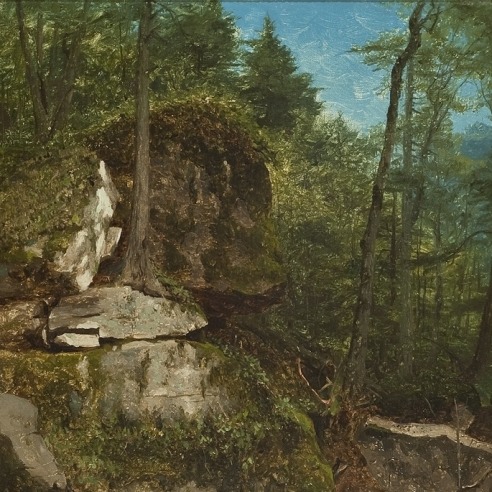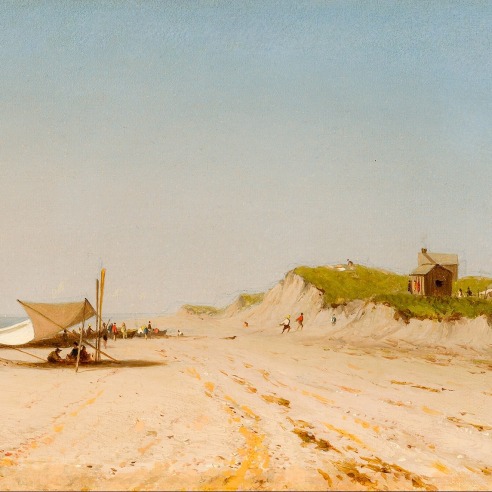
Sanford Robinson Gifford was a son of the Hudson River Valley, born in Saratoga County, New York, in the southeast Adirondacks, and raised in the town of Hudson, where his father owned an iron foundry. After attending Brown University for three semesters, Gifford went to New York City in 1845, where he studied drawing with John Rubens Smith, an English émigré who offered private instruction. In New York, Gifford also spent two years in classes at the National Academy of Design. The young man was much influenced during that time by the long shadow cast by Thomas Cole, the eminent landscape painter who today is considered the founder of the canonical American style of landscape painting, the Hudson River School. During this period, Gifford’s early interest in portraiture was transformed into a lifetime passion for landscape. From 1847 until 1852, Gifford submitted landscapes to the short-lived American Art-Union in New York and to the annual exhibitions of the National Academy of Design. In 1851, he was elected an associate member of the National Academy, and three years later, in 1854, a full academician.
In 1855 Gifford sailed to Europe, a necessary pilgrimage for young American artists who needed to see for themselves the Old Master paintings that were available in America only in replica. Gifford visited England, France, and Italy, meeting John Ruskin, the eminent English art critic, Jean-François Millet, the revered painter of French peasants, and traveling for part of the time with another young American artist, Albert Bierstadt. When Gifford returned to New York in 1857, he took a studio in the recently completed artist’s studio building at 15 West Tenth Street in Greenwich Village, which remained his New York City home for the rest of his life. Gifford’s landscape style evolved, in the wake of his two-year sojourn in Europe, from a Pre-Raphaelite-influenced literal transcription of nature to expansive, light-filled compositions that heralded the advent of his mature style, with a poetic concern for light and air, a style now called Luminism.
Gifford’s regular practice was to spend the summer sketching in scenic locales, often in collegial company with fellow artists, and then turn the sketches into finished oils in the Tenth Street Studio during the winter. His sojourn from May through August 1862, on the shores of Chesapeake Bay, was, however, no landscape artist’s summer jaunt. The previous year, on April 12, 1861, the forces of the Confederacy had fired on the federal installation at Fort Sumter, South Carolina. Gifford’s response was strong and dramatic. Impelled by patriotic fervor and anti-slavery convictions, he enlisted in the Seventh Regiment of the New York State National Guard. While the Civil War is as much a watershed in the narrative history of American art as in the life of the nation, Gifford’s situation was exceptional. While numerous artists recorded and interpreted aspects of the conflict, Gifford went not as an observer, but as a participant. The New York regiment was posted at various times in Virginia and Maryland in defense of the nation’s capital, Washington D.C., which was located perilously close to Confederate territory. Gifford served three tours of duty from 1861 to 1863 and was finally mustered out in 1868. While Gifford shared the duties of his regiment, it is also clear that he enjoyed a far greater degree of freedom than the ordinary soldier. Though his service proved relatively uneventful, and he never actually saw battle, the Gifford family did not emerge unscathed from the war. In the summer of 1863, the artist’s younger brother, Edward Gifford, died in service to the Union cause.
During his years in active service Gifford continued, as was his wont, to fill pocket-sized notebooks with on-the-spot sketches of his experiences and observations. (Two war-time sketchbooks are among a group of five in the collection of the Albany Institute of History and Art, New York, donated by Gifford descendants.) The War did not interrupt Gifford’s participation in the New York art world. He exhibited two canvases with Civil War themes: Sunday Morning in the Camp of the 7th Reg’t near Washington, D.C. (Sunday Morning at Camp Cameron, Near Washington, May, 1861), or Preaching to the Troops (The Union League Club, New York) and Bivouac of the Seventh Regiment—Arlington Heights (The Seventh Regiment Fund, Inc., New York) at the annual exhibition of the National Academy of Design, New York. In 1863, he exhibited Baltimore 1862—Twilight (now Fort Federal Hill at Sunset—Baltimore (The Seventh Regiment Fund, Inc., New York). These pictures met with enthusiastic critical and popular receptions.
Throughout his career, Gifford interspersed small-scale works, such as the present canvas, with larger pictures intended for public exhibition. The small works were sometimes plein-air sketches and sometimes fully realized compositions, often intended as very personal tokens of friendship. In 1864, for example, Gifford joined with almost fifty other artists in presenting William Cullen Bryant a portfolio of art in honor of his 70th birthday.
Sanford Gifford had a devoted circle of friends and patrons at the center of the New York artists’ community. In his 1867 Book of the Artists, Henry Tuckerman perceptively noted:
[Gifford’s] best pictures can be not merely seen but contemplated with entire satisfaction; ... their effect is the reverse of sensational; their subjects are often destitute of exceptional picturesqueness, but selected simply because they include average and suggestive traits, normal aspects, recognized and familiar charms. Sometimes Gifford’s landscapes exhibit an executive skill, a judicious treatment—an harmonious effect and impression, which can only result from conscientious fidelity to truth in art; they do not dazzle; they win; they appeal to our calm and thoughtful appreciation; they minister to our most gentle and gracious sympathies, to our most tranquil and congenial observation.
Fourteen years later, at a memorial service organized at The Metropolitan Museum of Art by his peers and colleagues, John Ferguson Weir, described Gifford’s art in a more personal way:
Gifford’s art was poetic and reminiscent. It was not realistic in the formal sense. It was nature passed through the alembic of a finely organized sensibility.... He valued ... the deeper values that remain in the memory as a residuum of impressions derived from nature; yet he was too skillful an artist not to understand with clearness that accuracy of statement, with reference to the physical conditions of nature ... is essential to all healthful effects of art. His sentiment was legitimate and true, because it was extracted from these very conditions.... He was a close student of nature, of her forms and facts, as well as of her moods. He recognized in the landscape that its expression, for him rested mainly in its atmosphere. He rendered this atmosphere palpably, with very subtle sympathy, with great delicacy; but the forms he flooded with it he drew firmly, for he well knew that the finest delicacies of nature are those that are associated with vigorous truths—and it thus that sentiment is distinguished from sentimentality in art.

